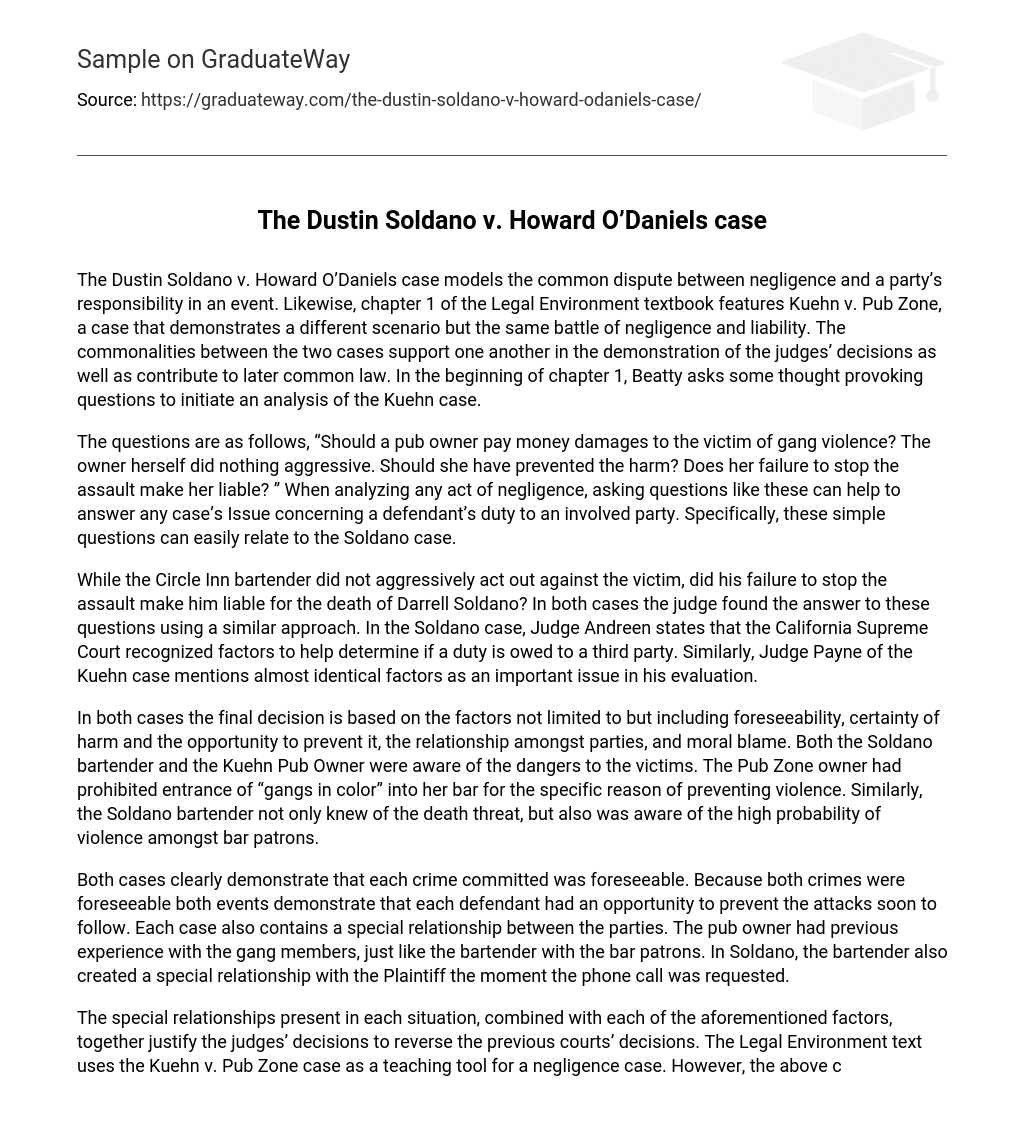The Dustin Soldano v. Howard O’Daniels case models the common dispute between negligence and a party’s responsibility in an event. Likewise, chapter 1 of the Legal Environment textbook features Kuehn v. Pub Zone, a case that demonstrates a different scenario but the same battle of negligence and liability. The commonalities between the two cases support one another in the demonstration of the judges’ decisions as well as contribute to later common law. In the beginning of chapter 1, Beatty asks some thought provoking questions to initiate an analysis of the Kuehn case.
The questions are as follows, “Should a pub owner pay money damages to the victim of gang violence? The owner herself did nothing aggressive. Should she have prevented the harm? Does her failure to stop the assault make her liable? ” When analyzing any act of negligence, asking questions like these can help to answer any case’s Issue concerning a defendant’s duty to an involved party. Specifically, these simple questions can easily relate to the Soldano case.
While the Circle Inn bartender did not aggressively act out against the victim, did his failure to stop the assault make him liable for the death of Darrell Soldano? In both cases the judge found the answer to these questions using a similar approach. In the Soldano case, Judge Andreen states that the California Supreme Court recognized factors to help determine if a duty is owed to a third party. Similarly, Judge Payne of the Kuehn case mentions almost identical factors as an important issue in his evaluation.
In both cases the final decision is based on the factors not limited to but including foreseeability, certainty of harm and the opportunity to prevent it, the relationship amongst parties, and moral blame. Both the Soldano bartender and the Kuehn Pub Owner were aware of the dangers to the victims. The Pub Zone owner had prohibited entrance of “gangs in color” into her bar for the specific reason of preventing violence. Similarly, the Soldano bartender not only knew of the death threat, but also was aware of the high probability of violence amongst bar patrons.
Both cases clearly demonstrate that each crime committed was foreseeable. Because both crimes were foreseeable both events demonstrate that each defendant had an opportunity to prevent the attacks soon to follow. Each case also contains a special relationship between the parties. The pub owner had previous experience with the gang members, just like the bartender with the bar patrons. In Soldano, the bartender also created a special relationship with the Plaintiff the moment the phone call was requested.
The special relationships present in each situation, combined with each of the aforementioned factors, together justify the judges’ decisions to reverse the previous courts’ decisions. The Legal Environment text uses the Kuehn v. Pub Zone case as a teaching tool for a negligence case. However, the above comparison between the book example with the Soldano case, makes it apparent that there is a common approach to this type of situation. In general, when cases are dealt with in similar manners an example is created for future cases to come.
The book points out that when cases like this are referred back to for use in future decisions they stand as precedence; the larger amounts of similar cases, the stronger the precedent. The commonality that is found in cases like Soldano and Keuhn contributes to a precedent which can be reflected within the doctrine of stare decisis. Just as Judge Andreen supported his opinion with cases such as Tarasoff, Andreen’s decision as well as Payne’s can now help to facilitate additional judicial decisions.
Therefore, it can be assumed that other negligence cases will come to a rational decision using the structured approach of deciding if the act was foreseeable. Negligence is a basic principle of law that is found in countless cases. Not all situations work in favor of the plaintiff (Chapter 1’s Big Red Traveling Carnival case for example). Nevertheless, whether a party is found liable or not, precedent should be followed and the final decision is should be made using the evaluation factors mentioned in both the Soldano and Kuehn cases.





